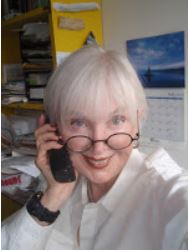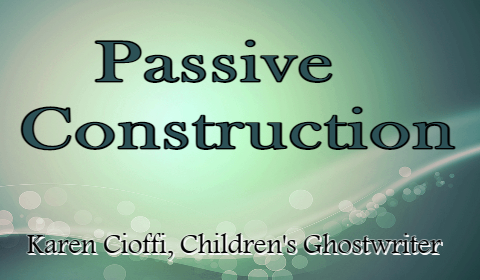Contributed by Carolyn Howard-Johnson
Writers of fiction are often told to avoid passive sentences. Nonfiction writers sometimes get the same advice.
The reasons for such admonitions are many. After all, they tend to tug on the forward momentum we are usually after. But passive construction can be used effectively, too. When we sense that there would probably be no passive constructions, we should listen. Our writing may improve if we force ourselves to accept passives regardless of their ugliness. We can utilize what they’re good at in our writing and—at the same time—recognize their flaws so we can avoid them when they are just plain ugly.
Luckily, good editors are here to help. Yours may help you avoid passive constructions by making suggestions to “activate” them. There are times, however, when you must do your own editing.
Here are some examples to try your hand at.
- “I was offended by the President’s proclamation.” (Some argue that this isn’t a true passive because the hidden subject is evident, but when you pick up the object of the preposition, “the President’s proclamation,” put it up front, and ditch the helping verb, you’ll see how the sentence comes alive.) Scroll down a bit to see the magic this makes!
- “Catherine was being watched.”
~Your edit: - “Catherine was being silly.”
~Your edit:
Here is your cheat sheet:
For the first you would, of course, make it “The President’s proclamation offended me.”
For the second, you’ll have to provide the intended subject. It might look like this:
“The fuzz watched Catherine.”
(So, maybe you’d be more formal and call them “coppers!”)
The third example might throw you a curve. That’s because it isn’t a passive sentence according to the strictest of definitions. Here’s the thing. We tend to assume a construction is passive when we see helper verbs and “ing” words. But these are not always passive indicators. That’s one more thing for you to figure out in addition to deciding whether you want to avoid a passive construction. You’ll find a complete discussion of the dreaded “ing” words in my The Frugal Editor.
You can still avoid the not-so-active sounding helper verb with a mini rewrite:
“Gracie thought Catherine was being silly.”
You might ask, “So, if these slowpoke constructions stall the forward motion of my prose, what are the good reasons for using them?”
Few, if any, etymologists argue that language usually doesn’t develop or change unless there is need. When we recognize what passive construction and its copycats can do for us, we may grow to love it.
Here are reasons you might want to intentionally use passive verbs:
- You want to slow down the movement in a saga sent in the 19th century. I do some of that (very judiciously!) in myThis Land Divided now being shopped by my agent. That the first chapter of that book won WriterAdvice.com’s Scintillating Starts contest proves that passive is pretty—sometimes.
- You need to set one character’s dialogue apart from another to avoid overworked, fussy dialogue tags or because the tenor of that voice suits that character’s personality better than strong active verbs.
- You’re writing political copy and you want to avoid pointing a finger at, say, the FBI because you don’t want to get put on the dreaded US No-Fly list. So instead of saying “The FBI is watching Carolyn.” You say, “Carolyn is being watched.” It’s a device that lets you avoid pointing a blaming finger at the perpetrator.
- If you write copy for pharmaceutical TV ads, your career could depend on knowing how to use passive voice. I watch TV commercials carefully because I do some acting and the voiceovers behind all those happy, healthy faces make me cringe. The use of passive voice clearly avoids assigning any responsibility for all those side effects and deaths. One actually says, “Deaths have happened.”
We need to know how to make verbs active, when to leave them alone, and, yep. When to use them to our advantage. That way, we can take a red pen to them when they are likely to brand us as amateurs, occasionally put them to very good use, and even learn to love them.
This article was first published at: https://www.writersonthemove.com/2019/03/learning-to-love-passive-construction.html

Carolyn Howard-Johnson is an award-winning novelist, poet, and author of the HowToDoItFrugally Series of books for writers. She taught editing and marketing classes at UCLA Extension’s world-renowned Writers’ Program for nearly a decade and carefully chooses one novel she believes in a year to edit. The Frugal Editor award-winner as well as the winner of Reader View’s Literary Award in the publishing category. She is the recipient of both the California Legislature’s Woman of the Year in Arts and Entertainment Award and the coveted Irwin award. She appears in commercials for the likes of Blue Shield, Disney Cruises (Japan), and Time-Life CDs and is a popular speaker at writers’ conferences. Her website is www.HowToDoItFrugally.com.

Whether you need help with ghostwriting or rewriting, let me take a look at your children’s story. Just send me an email at: kcioffiventrice@gmail.com. Please put “Children’s Writing” in the Subject box. Or, give me a call at 347—834—6700
Let’s get your idea off the launch pad or your outline into a publishable story today!
Or, if you’d rather give it a shot and do-it-yourself, check out my book, HOW TO WRITE A CHILDREN’S FICTION BOOK.
MORE ON WRITING FOR CHILDREN
Picture Books – What Grabs an Editor?
Walking Through Walls Book Trailer


1 thought on “Learning to Love Passive Construction”